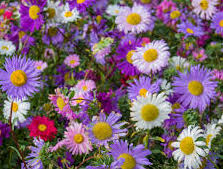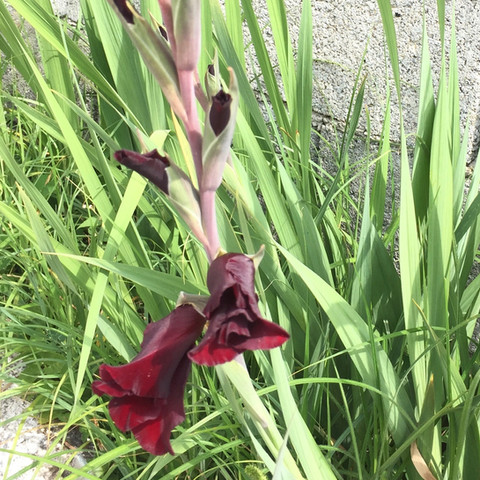AGE-OLD FLOWERS LOST FROM MY GARDENS
This is a nostalgic post, written, as it happens, by someone of a certain age.
Nowadays, towards the end of winter, you can go to a garden centre, spend a little money, and go back home with ‘readymade’ flowers.
Such flowers also have a sell-by date.
But it wasn’t always like this. Once upon a time, many plants could always be found in people’s gardens (including urban ones).
Neighbours were in the habit of exchanging plants.
One neighbour would have a knack for growing one plant, another for growing another; each flower had a reason to exist.
Today, I would like to introduce you to some of the plants I’ve been able to rescue from abandoned and decayed ruins in my neighbourhood.
It should be added that up until a few years ago one could still find these plants in myriad local gardens.

The rose – both pink and red – and used to make syrup, was a common sight.
I have already written about this plant on several occasions.

There was the Sedum telephium commonly known as ‘Erba della Madonna’ (‘Mary’s Grass’)
– I’ve always only seen it with pink flowers, but I know that it can also have white ones.
According to studies conducted by the universities of Florence and Pisa on a variety of Sedum telephium specimens, and following the experiments of Dr Balatri of the Ospedale San Giovanni di Dio in Florence, it has been proven that this plant possesses extraordinary properties. It can be deployed to cure ulcers, whitlow, abscesses, dermatitis, burns, and further, facilitate the expulsion of subcutaneous bodies. These traditional plant remedies were of course well-known and very popular amongst our ancestors. The use of fresh leaves, once skinned of their lower part, applied directly to the skin, or sometimes minced, was a
renowned cure against whitlow. Dr Balatri’s article devoted to this plant can be found in this article.

Another well-known sedum was the Sedum sieboldii or ‘Erba Teresina’ (Teresa’s Grass), which flowers in October on the occasion of St Teresa of Avila, after whom it is named.

We found the Bergenia, or Bergenia crassifolia, characterised by wide and fleshy leaves, which once flowered towards the end of winter in warmer spots, (here not before April), and would adorn the borders of all gardens with its pink flowers.
In the past, women cherished a secret: Bergenia was used for vaginal irrigation to relieve soreness and inflammation of the vaginal cavity.
Those who knew about this plant prepared a concentrated extract by boiling its rhizomes and roots…

There was the wonderful lilac, Syringa vulgaris, here>>>, whose overpowering scent announces the arrival of spring.
But how many of us remember that this plant can also cure heart diseases, or hypertension?
And further, how many of us recall that its flowers can be used to produce an incredibly perfumed oil essence that alleviates rheumatism and leg bloating caused by the summer heat?

We found the precious Calicanto, Chimonanthus Praecox (winter too wants its flower and it sown perfume).
You can find all about it in this post >>>

And the periwinkle, Vinca minor, click here>>> to read the post, a ground cover shrub, offering blue flowers, which despite being toxic, was once used to produce love potions.
Nowadays, many beneficial properties are ascribed to it; these include curing hypertension and ensuring
a healthy functioning of the brain.
It is known that the periwinkle contains alkaloids which dilate blood vessels and can therefore improve the one’s overall blood circulation.

The simple marigold, Tagetes patula, is known to many for its anti-parasitic and anti-fungal repellent properties in both gardens and orchards.
Yet many have forgotten that this plant was also used for our own health; the marigold essential oil is a good antimycotic, effective against mosquitoes and lice when added to a shampoo insofar as it contains a small quantity of antibiotic… it is also commonly known as the Mexican Calendula.

The calendula or Calendula officinalis could not fail to make an appearance in this essay: you can read more about this plant in this post>>>
The calendula ointment contains incredible lenitive properties; produced from its orange flower heads, it is highly effective against baby nappy rashes, but also used as an infusion by housewives to regulate one’s cycle.
It is for its latter use that it has gained the popular name ‘Maria’s gold’. The name calendula originated
from the fact that this plant flowers almost all year round on the first day of each month.
Amongst the annual plants, we found the ever-present aster, zinnias, cosmos, gladiolus, dahlias, hoary stock, snapdragons, carnations, and fuchsias.
The latter was locally called Mary’s Earrings, and gained its name from its multi-coloured flower-heads that attracted a proliferation of bees.
It seems that the zinnia was a kind of laughter-flower, probably owing to its vivid colours that put a smile on one’s face.

Tall and precious, called by my grandmother bismalva, was the Alcea rosea, found in various colours, from white to dark red, as well as in the more classic pink, sharing pretty much the same properties as those of its cousin – the malva – which you can read about by clicking here>>>

The Giglio di Sant’ Anna (St Anne’s Lilium), Hosta plantaginea, was used for borders with its large leaves and its white perfumed flower.

Or one could find the Giglio di Sant’Antonio (St Anthony’s Lilium), incredibly perfumed…we’ve all carried this flower during our first communion procession.

And the orange day-lily, Hemerocallis: few of us remember this flower is edible and has a lemony flavour, to find out how to differentiate this species from the other protected one, which grows in the woods, click here, the Giglio of San Giovanni (St John’s Lily).

The so-called guardiatrun (Sempervivum tectorum) safeguards our homes, or rather our roofs.
It lives off nothing but a little soil transported by the wind that attaches itself to the ‘ciappe’ (slate).
It defied rain, frost, and snow, whilst protecting the home from lightning and
rainstorms.
Back in the seventies, at my mother-in-law’s house we removed one measuringmore than a square metre! It could also be used to remove corns and calluses, especially those occurring between one toe and another.
A simple way to remove and relieve one of a painful corn was to place a coarsely minced leaf in a bandage and wrap it to the sore spot.
Many know this plant as the ‘Erba dei calli’, literally, the ‘corn grass’.

Gustav Klimt - Italian garden
All these plants and flowers are rustic; simple, they thrived on benign neglect, and made little demands on their carers: indeed, women of the past had little time to devote to their gardens.
Often young girls used these plants to adorn our country church altars.
I still recall how comari – local ladies - on Sunday, before mass, in the square, would exchange branches,
bulbs, and seeds: ‘Maria – I brought you the zinnia seeds – have you the marigold for me?
Knowledge from a bygone past, from lost gardens; when information was exchanged by word of mouth, and the names plants were either associated with their overall shape or with the relief they brought…there was no such thing as Wikipedia, no blogs, no social media…but a lot of sharing went on!
In the gardens of the rich grew the magnificent Peony…

Traduzione: Dr Emilia Terracciano (University of Manchester)
Share the post! and then come back, you will find interesting experiences .
If you want, you can subscribe to the news letter by clicking here>> so you don't miss any articles.
Lella
Lella Canepa, creator of " Women from Yesterday to Today " a fantastic exhibition later translated into a book and of " Erbando " a sophisticated event which always produces a " sold out " immediately, also translated into a Manual where you learn to learn about and collect edible wild herbs as our ancestors did.
Lella Canepa has always loved everything that is spontaneous, simple and natural and has cultivated a passion for everything that surrounds the manual world of women for years. passed down for generations from his mother, grandmother and great-grandmother.
If you want, you can contact Lella here>>

All food or pharmaceutical uses indicated are for informational purposes only, the result of personal experience. I decline any responsibility for their use for curative, aesthetic or food purposes.
























Comentarios